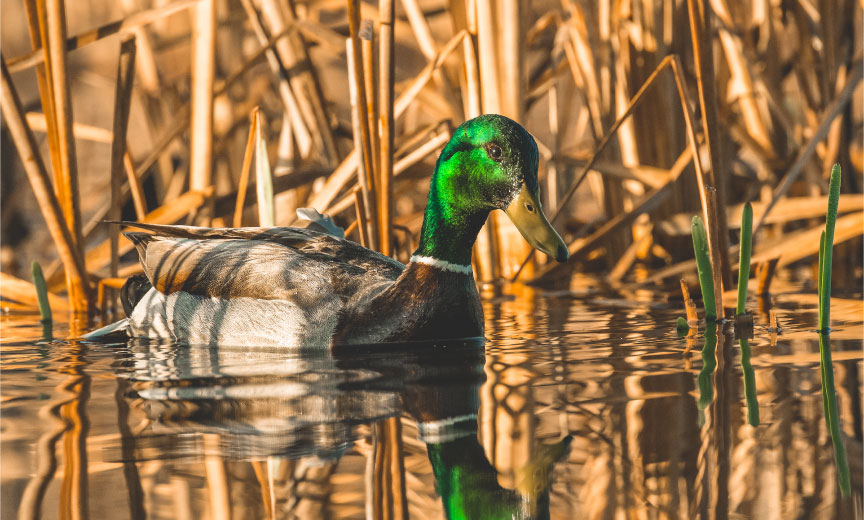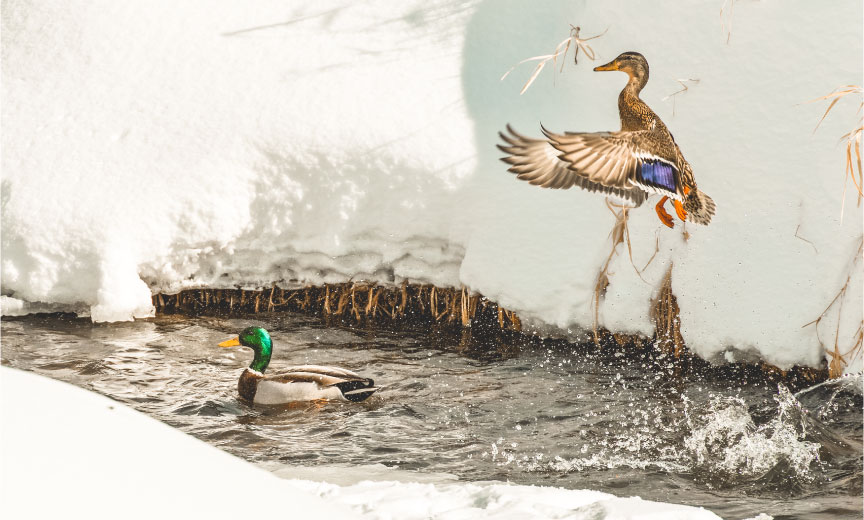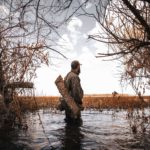Story of the Iconic Greenhead Mallard
Even if you’re a brand new duck hunter, you’re no doubt familiar with the mallard (Anas platyrhynchos), also called a greenhead. This adaptable bird is commonplace throughout most of the country and for most of the year. It’s likely the most numerous duck species in the world and is the ancestor to most domestic ducks. In this species profile, we’ll dive into the description, range/habitat, conservation issues and some hunting tips for this popular waterfowl species.
Description and Life History of the Mallard
The mallard is a relatively large duck species, measuring about 20 to 26 inches in length and weighing about 2 to 3 pounds (All About Birds 2018; NatureServe 2018). It has a large and long body, a thick neck, round head, flat bill, and a short pointed tail that sticks up above the water when floating. Drakes (males) look quite different from hens (females) during the breeding season, although they look similar during their summer molt period (called eclipse plumage). The most prominent part of a drake’s coloration is its bold, iridescent green head. They have a bright yellow bill and white ring around their neck, which separates the head from their grayish brown colored body. Their rear tail feathers are black and white, and they have curious curled black feathers on the top side of their tails. Hens and juvenile birds are mottled brown almost from head to tail. Hen bills are usually more orange and brown rather than yellow. Both sexes have orange legs and feet, and brownish wings with a bright blue wing patch (speculum) that is bordered with white and black. Hens are the more vocal of the sexes, making the classic duck quack in a series of 2 to 10 notes. Drakes do not quack like that – instead, they make a raspy, humming sound (All About Birds 2018).
Mallards form monogamous pair bonds in the previous fall or winter, with a courtship display that consists of the male dipping its bill in the water and splashing about (All About Birds 2018). After mating, the pair searches for a nest site which is typically on the ground and concealed by thick vegetation, but it may be located on a tree stump or nest platform (National Audubon Society 2018). The nest is constructed by the female who forms a shallow bowl of vegetation and twigs approximately one foot across and lining it with downy feathers. The hen will lay 5 to 10 creamy and olive-colored eggs and incubate them by herself for about 26 to 30 days (National Audubon Society 2018; NatureServe 2018). The hatched ducklings are led to water by the hen within the next day. The ducklings feed themselves, but they are tended by the hen until they are able to fly on their own at 52 to 60 days (National Audubon Society 2018).

Mallards are part of the dabbling duck group (also called “puddle ducks”). They feed by floating in the water and simply tipping forward to graze on underwater plants and invertebrates, rather than diving for them (All About Birds 2018). Primary natural food sources include seeds, leaves, tubers and roots of many plants (e.g., sedges, grasses, pondweeds, smartweeds, etc.), as well as acorns and other mast (National Audubon Society 2018). They also eat insects, crustaceans, mollusks, frogs, earthworms and small fish. In cultivated fields, they will also readily consume grain (e.g., wheat, rice, milo, corn, soybeans, etc.), particularly if the fields are somewhat flooded. Because they are dabblers, mallards only need a foot or two of water to provide optimum foraging. They will often feed heavily in the early morning hours and late afternoon.
Adult mallards do not have many natural predators that can catch them, except various raptors (e.g., eagles, hawks, falcons, owls). However, hens are vulnerable to ground predators when they are on their nests. Eggs and hatched broods are very susceptible to predation from crows, mink, raccoons, skunks, foxes, coyotes, snapping turtles and even large fish (University of Illinois Extension 2018).
Range and Habitat of the Mallard
As mentioned, the mallard is probably one of the world’s most numerous and wide-ranging duck species. Most of the global population occurs throughout the Northern Hemisphere from Canada to Mexico in North America, but also across Europe and Asia. The North American population arrives in northern breeding areas from March to June and migrates south again from August to November, depending on winter conditions (NatureServe 2018).
The mallard primarily uses shallow water systems with lots of vegetation during its breeding and brood-rearing phase. Ponds, lakes, rivers, sloughs, swamps, marshes, flooded fields, prairie potholes and bays can all be used by the mallard. In cities and suburbs, the mallard may also thrive using backyard water features, fountains and storm water detention ponds. The mallard is a freshwater duck and it rarely uses brackish or coastal waters.
Conservation Issues for the Mallard
The mallard is listed as globally secure and of Least Concern by the IUCN Red List (NatureServe 2018). The 2014 North American breeding population alone was estimated to be approximately 11.6 million birds (All About Birds 2018). However, some populations have been decreasing steadily over the last several years, particularly eastern mallards that use the Atlantic flyway.
Historic threats to mallards included destruction of habitat (e.g., prairie pothole wetlands), use of lead shot and overharvest. Wetland restorations continue to help provide habitat for ducks, but there is likely a persistent population effect due to historic destruction. The mandated use of non-toxic shot for waterfowl species and migratory birds has reduced the chance of lead poisoning. Mallards are heavily hunted in North America, with 3 to 5 million ducks being harvested nationwide each year (Flyways 2018). However, they are closely monitored and it has not appeared to affect the breeding population in any significant way.
Hunting Opportunities for the Mallard
Because the mallard is so prevalent across the country, you’re probably not too far from some decent duck hunting. They can be found across all four flyways (Pacific, Central, Mississippi, and Atlantic). Here are some duck hunting tips to help you get out after them this fall.
Equipment and Bag Limits
A 12-gauge shotgun is the only way to go for most waterfowl hunting, particularly if you expect to see some geese, too. Likewise, a modified choke is probably the best all-around shotgun choke choice for duck hunting. Improved cylinder may be too open for ducks that aren’t flying in close and full may be too tight. But you need to try some different shotgun loads and see how your individual shotgun patterns them. Although mallards are large ducks they can still fly somewhat fast, which means you need to lead them well unless they have flared their wings and have slowed down significantly. As for ammo choice, 3-inch shells with shot sizes of No. 3 or 4 should work great for these tough birds.
Since they are migratory bird species, you will need to buy a federal duck stamp and use non-lead shot. Current daily bag limits for most duck species are 6 birds, no more than 4 of which can be mallards (only 2 hens allowed). In the Atlantic flyway, the U.S. Fish and Wildlife Service proposed a decrease to this bag limit for the 2019-2020 season, dropping it to 2 mallards daily, both of which could be hens.

Mallard Hunting Techniques
As for mallard hunting techniques, it depends on the time of the season and the area you are hunting. Early season birds are generally in smaller groups and not truly migrating anywhere yet. Late season birds will be flocking up and heading south. On smaller ponds, wetlands, or flooded fields, using a dozen decoys may be enough to catch a passing flock’s attention. Use mostly hen decoys to attract drakes, and toss in a few other duck species or goose decoys to make it more realistic. On larger bays or lakes, you’ll probably need larger decoy spreads to attract ducks.
If possible, identify two hunters in your group to do the calling. The lead caller should be the more experienced duck hunter and will be responsible for reading the flock. Loud hen comeback calls work great to get a flock’s attention. The supporting caller can add hen calls or make drake whistles or feeding chuckles to add more confidence to the sound.
Waterfowl hunting is a game of adaptation. What worked one day (or even earlier that same morning) may not work later. You need to adjust your decoy spread, position, and calling until you find what works. While that can be really frustrating, it’s also very satisfying when you put a pattern together and see a flock set their wings toward you.
Sources
All About Birds. 2018. Mallard. Accessed at: https://www.allaboutbirds.org/guide/Mallard/lifehistory
Flyways. 2018. Harvest Trends: Nationwide Harvest Estimate for the Mallard. Accessed at: https://flyways.us/regulations-and-harvest/harvest-trends
NatureServe. 2018. NatureServe Explorer: An online encyclopedia of life. Accessed at: http://explorer.natureserve.org
National Audubon Society. 2018. Guide to North American Birds. Accessed at: https://www.audubon.org/field-guide/bird/mallard
University of Illinois Extension. 2018. Wildlife Directory. Accessed at: https://extension.illinois.edu/wildlife/directory_show.cfm?species=mallard
Last modified: July 19, 2022













0 Responses to :
Mallard – A Waterfowl Species Profile